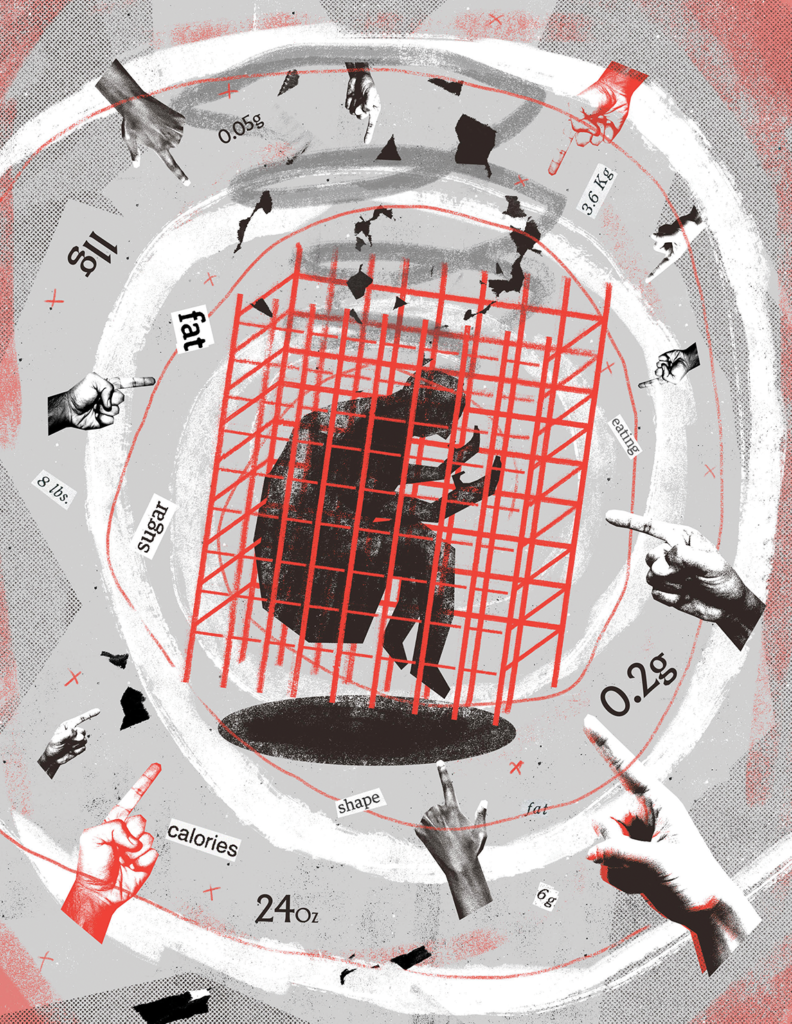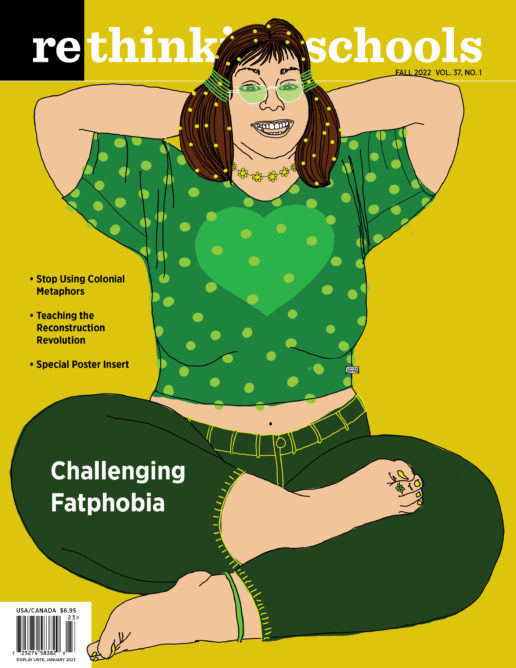Fatphobia Showed Up in My Classroom
Here’s What I Wish I Had Done Differently
Illustrator: Nate Kitch

It is the noisiest time of the day at school. It’s lunchtime and I’m sitting with two of my 3rd graders in the basement cafeteria of our public school building in Central Harlem. Today we’re talking about their favorite drinks. They buy the 24-ounce AriZona iced teas from the corner store each morning before school, and it sometimes seems like drinking these iced teas is the highlight of their day. Bruised ego about my pedagogy aside, today I’m trying to teach them a bit of nutrition and math.
“Do you see what this says on the back? Do you know what a serving is? That means how much you should drink at once. This says this bottle holds three servings. Don’t you usually drink these all at once?”
Their smiles are at once mischievous and proud.
“How much sugar does this label say is in one serving?” I ask.
“21 g.”
“That’s right. The g means grams, so that’s 21 grams. So if there’s 21 grams of sugar in one serving, how many grams of sugar are in the whole bottle?”
It takes them a minute to do the mental math, but once we settle on an answer I continue.
“Do you know much sugar you’re supposed to have in a day? 25 grams. And you’re having 63 grams of sugar just in one drink during lunch? Does that seem healthy to you?”
They give me an unimpressed shrug, before rebutting my well-laid-out argument. “But it’s so good, Mr. Brosbe!”
I’ve been thinking back on this conversation and the many like it that I’ve had in my 12 years of teaching with no small amount of disappointment and shame. I can see clearly now that my efforts were not only completely ineffective, but they were steeped in the language of diet culture and fatphobia.
I have only recently begun to unpack the way I’ve internalized fatphobia and diet culture. As I go, I am learning about the ways these ideologies are intertwined with other oppressive ideologies. For example, consider the ways under white supremacy that Black people’s bodies are either considered undesirable or over-sexualized. Meanwhile, ableism tells us that fat people inherently have less value. Patriarchy enforces body standards unevenly. Classism often connects the stigmatization of poverty with being fat. These overlapping oppressive ideologies create a toxic worldview for anyone (most of us) who fails to conform to unrealistic body size standards.
It hurts my heart to think about the impact of my language on the 8-year-olds in my class. Whatever my concerns about obesity or diabetes or whatever might have been, the statistics on disordered eating — the wide range of irregular eating behaviors, including those that do not warrant a diagnosis — are shocking.
According to one estimate, 5 million to 10 million women and 1 million men across the country battle eating disorders. A report by Common Sense Media found that 80 percent of 10-year-old girls have been on a diet. This is particularly troubling considering that research shows diets are more likely to cause eating disorders, depression, or fluctuating weight than sustained and healthy weight loss.
I try to give myself grace, by remembering Beverly Daniel Tatum’s analogy for white supremacy. Tatum compares white supremacy to smog in the air; we all breathe it in. Fatphobia, many have pointed out, is rooted in white supremacy and I have been inundated with fatphobic messaging throughout my life. As an educator, I have an obligation to unlearn these messages and provide healthier, nontoxic, liberatory messages for my students.
Like so many other forms of oppression prevalent in the United States, fatphobia imparts shame and failure on us by placing the burden for wellness on us as individuals rather than the systems we live under.
Like so many other forms of oppression prevalent in the United States, fatphobia imparts shame and failure on us by placing the burden for wellness on us as individuals rather than the systems we live under. This is a recurring tool of social control under racial capitalism. Diet culture would have us believe that the key to health is in our personal choices about what we eat, how much we eat, and whether we move our bodies enough in certain ways. As a result, we are too distracted or busy to focus our energy on dismantling the structural causes of our collective illness such as poverty or environmental racism. In this context, it’s worth reflecting on my paternalistic desire as a white cis man to protect and police the bodies of my Black and Brown students. By pushing them to think about their “unhealthy” drink, I inserted myself into a decision that was none of my business. Instead of abusing my authority to shame my students, I could have used my energy to act in solidarity with them. I could have joined the efforts advocating for more appetizing school lunches, better access to fresh produce in Central Harlem, or any number of larger social determinants of my students’ health.
Like all forms of oppression, fatphobia sneaks its way into our explicit curriculum as well as our “hidden curriculum.” It shows up in the characters our students read and don’t read about, the way we teach them about nutrition and exercise, and the casual conversations we have about food each day.
As educators, we can embed our conversations about nutrition within a larger understanding of health, wellness, and the systems that shape them. In doing so, we can teach kids to trust their intuition around food and love their bodies at any size.

